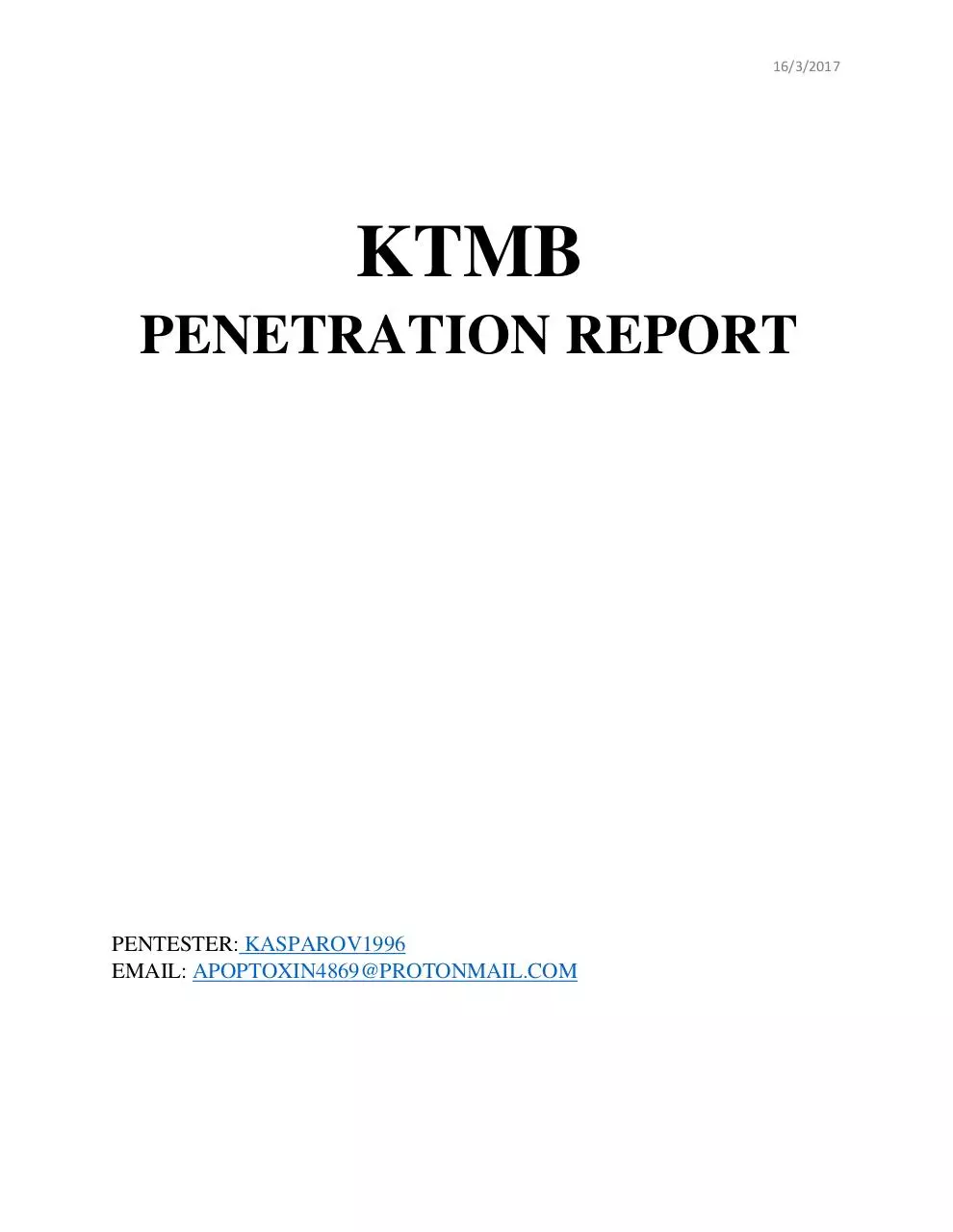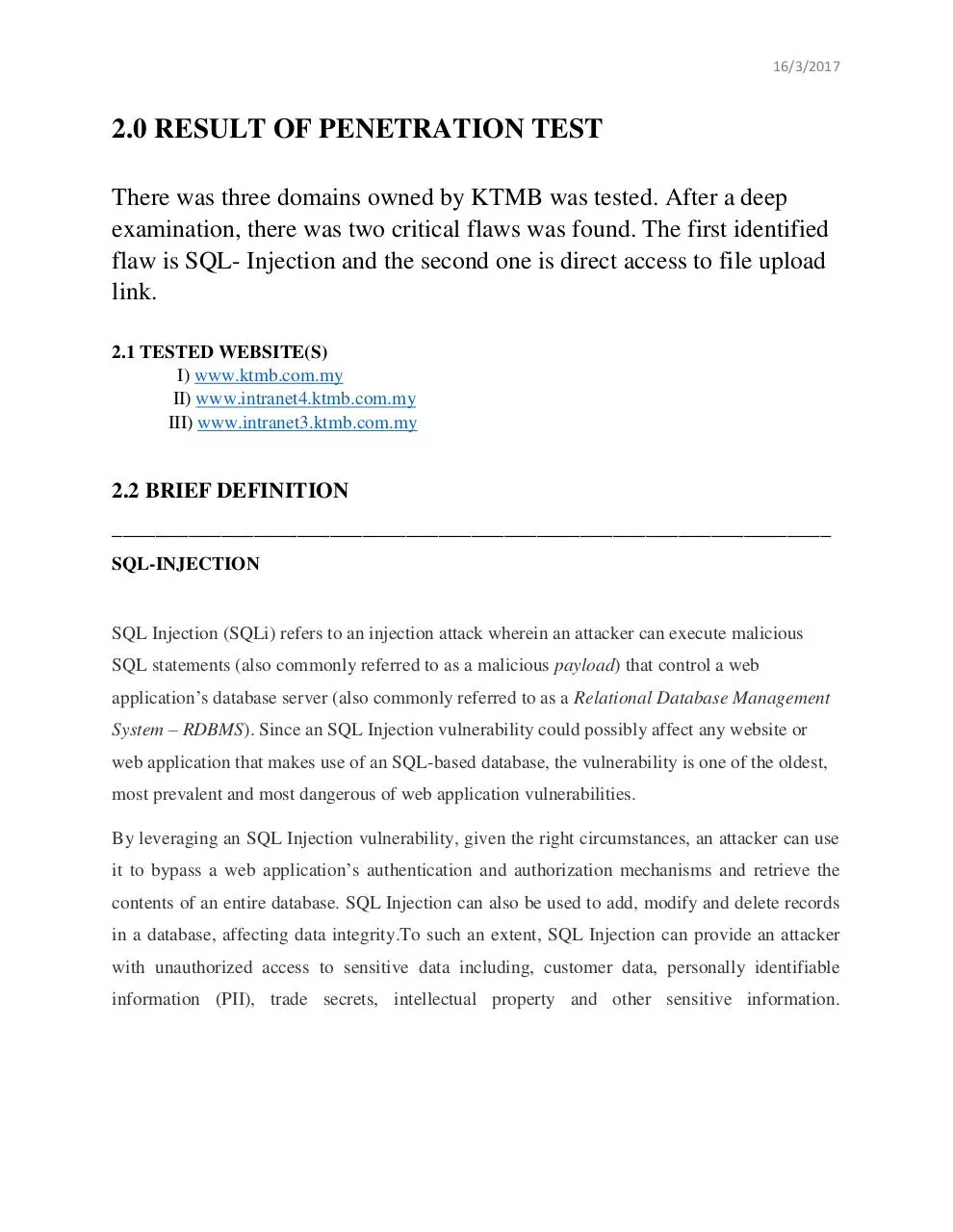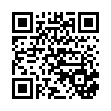KTMB REPORT (PDF)
File information
This PDF 1.4 document has been generated by Online2PDF.com, and has been sent on pdf-archive.com on 03/06/2017 at 20:35, from IP address 118.100.x.x.
The current document download page has been viewed 681 times.
File size: 560.14 KB (9 pages).
Privacy: public file





File preview
16/3/2017
KTMB
PENETRATION REPORT
PENTESTER: KASPAROV1996
EMAIL: APOPTOXIN4869@PROTONMAIL.COM
16/3/2017
16/3/2017
1.0 SUMMARY
This penetration test was conducted solely by the author without any intention
to cause any damages to KTMB. All activities were conducted in a manner that
simulated a malicious actor engaged in a targeted attack against KTMB with the
goals of:
i)Identifying if a remote attacker could penetrate KTMB’s defenses
ii)Determining the impact of a security breach on:
-Confidentiality of the company’s private data
- Internal infrastructure and availability of KTMB’s information systems
Efforts were placed on the identification and exploitation of security
weaknesses that could allow a remote attacker to gain unauthorized access to
organizational data. The attacks were conducted with the level of access that a
general Internet user would have. The assessment was conducted in accordance
with the recommendations outlined in NIST SP 800-1151 with all tests and actions
being conducted under controlled conditions.
REF: http://nvlpubs.nist.gov/nistpubs/Legacy/SP/nistspecialpublication800115.pdf
16/3/2017
2.0 RESULT OF PENETRATION TEST
There was three domains owned by KTMB was tested. After a deep
examination, there was two critical flaws was found. The first identified
flaw is SQL- Injection and the second one is direct access to file upload
link.
2.1 TESTED WEBSITE(S)
I) www.ktmb.com.my
II) www.intranet4.ktmb.com.my
III) www.intranet3.ktmb.com.my
2.2 BRIEF DEFINITION
__________________________________________________________________
SQL-INJECTION
SQL Injection (SQLi) refers to an injection attack wherein an attacker can execute malicious
SQL statements (also commonly referred to as a malicious payload) that control a web
application’s database server (also commonly referred to as a Relational Database Management
System – RDBMS). Since an SQL Injection vulnerability could possibly affect any website or
web application that makes use of an SQL-based database, the vulnerability is one of the oldest,
most prevalent and most dangerous of web application vulnerabilities.
By leveraging an SQL Injection vulnerability, given the right circumstances, an attacker can use
it to bypass a web application’s authentication and authorization mechanisms and retrieve the
contents of an entire database. SQL Injection can also be used to add, modify and delete records
in a database, affecting data integrity.To such an extent, SQL Injection can provide an attacker
with unauthorized access to sensitive data including, customer data, personally identifiable
information (PII), trade secrets, intellectual property and other sensitive information.
16/3/2017
_________________________________________________________________________________________
UNSECURE DIRECTORY LISITING
Properly controlling access to web content is crucial for running a secure web
server. Directory traversal is an HTTP exploit which allows attackers to access
restricted directories and execute commands outside of the web server’s root
directory.
Web servers provide two main levels of security mechanisms
Access Control Lists (ACLs)
Root directory
An Access Control List is used in the authorization process. It is a list which the
web server’s administrator uses to indicate which users or groups are able to
access, modify or execute particular files on the server, as well as other access
rights.
16/3/2017
3.0 PROOF OF CONCEPT
3.0.1 SQL- INJECTION
1.0
www.ktmb.com.my
SEVERITY = HIGH
http://www.ktmb.com.my/ktmb/index.php?r=portal%2Fsearch2&id=eHR5c2RmcXFVdElzQm9
xQ2FBOTEvdz09&title=vulnerable+parameter
NOTICE THAT AFTER ADDING SINGLE QUOTE AFTER THE TEXT WILL CAUSE
THE WEBPAGE ERROR.
Indeed this is a SQL error that can lead to SQL Injection attack.
16/3/2017
2.0
www.intranet3.ktmb.com.my
SEVERITY = HIGH
http://intranet3.ktmb.com.my/CRS/receive(Detail).asp?crs=1702280520400
WEB SERVER: Windows 2000
WEB APPLICATION TECHNOLOGY: ASP.NET, ASP, Microsoft IIS 5.0
BACK-END DBMS: Microsoft SQL Server 2012
16/3/2017
UNSECURE DIRECTORY LISITING
3.0
http://intranet4.ktmb.com.my/ktmb/ckeditor/ckfinder/ckfinder.html?type=Imag
es&CKEditor=Articles_content_my&CKEditorFuncNum=1&langCode=en
16/3/2017
4.0 CONCLUSION
The impact is serious. It is highly recommend for you to fix this flaws
immediately as it threatens your system. I’ll not responsible for the damage caused
by this documentation.
Download KTMB REPORT
KTMB REPORT.pdf (PDF, 560.14 KB)
Download PDF
Share this file on social networks
Link to this page
Permanent link
Use the permanent link to the download page to share your document on Facebook, Twitter, LinkedIn, or directly with a contact by e-Mail, Messenger, Whatsapp, Line..
Short link
Use the short link to share your document on Twitter or by text message (SMS)
HTML Code
Copy the following HTML code to share your document on a Website or Blog
QR Code to this page

This file has been shared publicly by a user of PDF Archive.
Document ID: 0000606908.